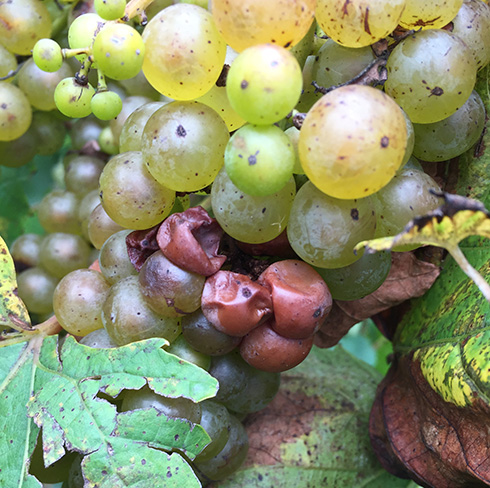Late season cultural and chemical options for diseases in grapes—don’t wait!
High disease pressure across Michigan can lead to bunch rot and sour rot issues near harvest.

The major grape growing regions of Michigan (i.e., the northwest and southwest portions of the Lower Peninsula) saw over 2 inches of rainfall in the last week. Grapes are nearing maturity with growers likely to begin harvesting next week in parts of the state. Lots of rain on ripening berries means high disease pressure right now in grapes.
It is too late to spray for downy and powdery mildew, but there is a significant risk of crop loss due to Botrytis bunch rot (Photo 1) and sour rot (Photo 2) that still need to be managed using cultural or chemical methods. There are other fruit rots we will not discuss in this article that are less important at grapes harvest (e.g., ripe rot, bitter rot or macrophoma rot). This article gives some background into Botrytis bunch rot and sour rot and provides some recommendations as we approach harvest.
Botrytis bunch rot background
After veraison, Botrytis bunch rot (caused by the fungus Botrytis cinerea) shows up as individually infected berries in a cluster turn brown to red. If there is high moisture, the fungus sporulates profusely and develops a characteristic gray/fluffy appearance. These initial B. cinerea infections occurred earlier in the season. We are now in the secondary phase, where split fruit or insect damaged fruit allow the pathogen to spread rapidly and increase damage caused by bunch rot.
Sour rot background

Sour rot symptoms include 1) clusters that smell like vinegar, 2) juice that drips over the fruit surfaces, 3) a melting-type decay with skin slippage and 4) vinegar flies and larvae typically present. Sour rot is a disease complex caused by several organisms including filamentous fungi (e.g., Alternaria, Aspergillus, Cladosporium, Rhizopus, and Penicillium), yeasts and bacteria (e.g., Acetobacter). Infections from these pathogens are favored by wet weather and wounds or injuries to fruit. These infections can be the result of any mechanical injuries, bird pecks, insect feeding or fruit splitting (i.e., caused by pathogens like powdery mildew or swelling from excessive rain).
Cultural management
Canopy management practices such as fruit zone leaf removal, shoot positioning and hedging are well-established methods used to increase sunlight and air flow, and the penetration of chemical sprays into the grapevine canopy, and most importantly the fruit zone. These practices can reduce the conditions that favor Botrytis bunch rot and sour rot. Not only do these practices reduce fruit rots and the presence of pests, but they are also known to reduce shading enhancing fruit maturity (ripening), which is desirable in Michigan’s short and variable cool-climate growing season.
Managing insect populations reduces the number of infection sites available to Botrytis bunch rot and sour rot. For sour rot, prevent wounds and lesions by controlling primary pathogens and insect pests. Additionally, minimize mechanical injury (i.e., from hedging or leaf pulling).
Recent damaging winds and rain in the northwest Michigan AVAs (Leelanau and Old Mission) have caused widespread reports of berry split, so this time of the growing season is critical to be scouting for the presence of fruit fungus and insect pressure. For more information on how severe late-season weather conditions can impact pest activity, see “Weather events lead to biotic pressures as grape harvest approaches” from Michigan State University Extension.
Chemical management
There are a number of fungicide products labeled for Botrytis bunch rot. Begin fungicides at bloom time if chemically managing Botrytis bunch rot. Be prepared to make additional fungicide applications when fruit clusters begin to close, especially in tight-clustered varieties. Unfortunately, since sour rot is a disease complex involving many different fungi, there are no chemicals effective specifically for sour rot.
If you are planning on late season fungicide applications, be aware of the label restrictions. The pre-harvest interval (PHI) is critical as we approach harvest. The table below outlines products that are currently labeled for Botrytis bunch rot control.
|
Trade name |
Active ingredient |
FRAC group |
PHI (days) |
|---|---|---|---|
|
Elevate |
fenhexamid |
17 |
0 |
|
Endura |
boscalid |
7 |
14 |
|
Fervent |
Isofetamid + tebuconazole |
7 + 3 |
14 |
|
Flint |
trifloxystrobin |
11 |
14 |
|
Inspire Super |
difenoconazole + cyprodinil |
3 + 9 |
14 |
|
Intuity |
mandestrobin |
11 |
10 |
|
Kenja |
isofetamid |
7 |
14 |
|
Luna Experience |
fluopyram + tebuconazole |
7 + 3 |
14 |
|
Pristine |
pyraclostrobin + boscalid |
11 + 7 |
14 |
|
Rovral |
iprodione |
2 |
7 |
|
Scala |
pyrimethanil |
9 |
7 |
|
Switch |
cyprodinil and fludioxonil |
9 + 12 |
14 |
|
Vangard |
cyprodinil |
9 |
7 |
Note particularly the FRAC group of these fungicides. If you have been using fungicides from the same FRAC group, you have been using the same type of material all season and you should choose a different FRAC group if the PHI allows you to.



 Print
Print Email
Email